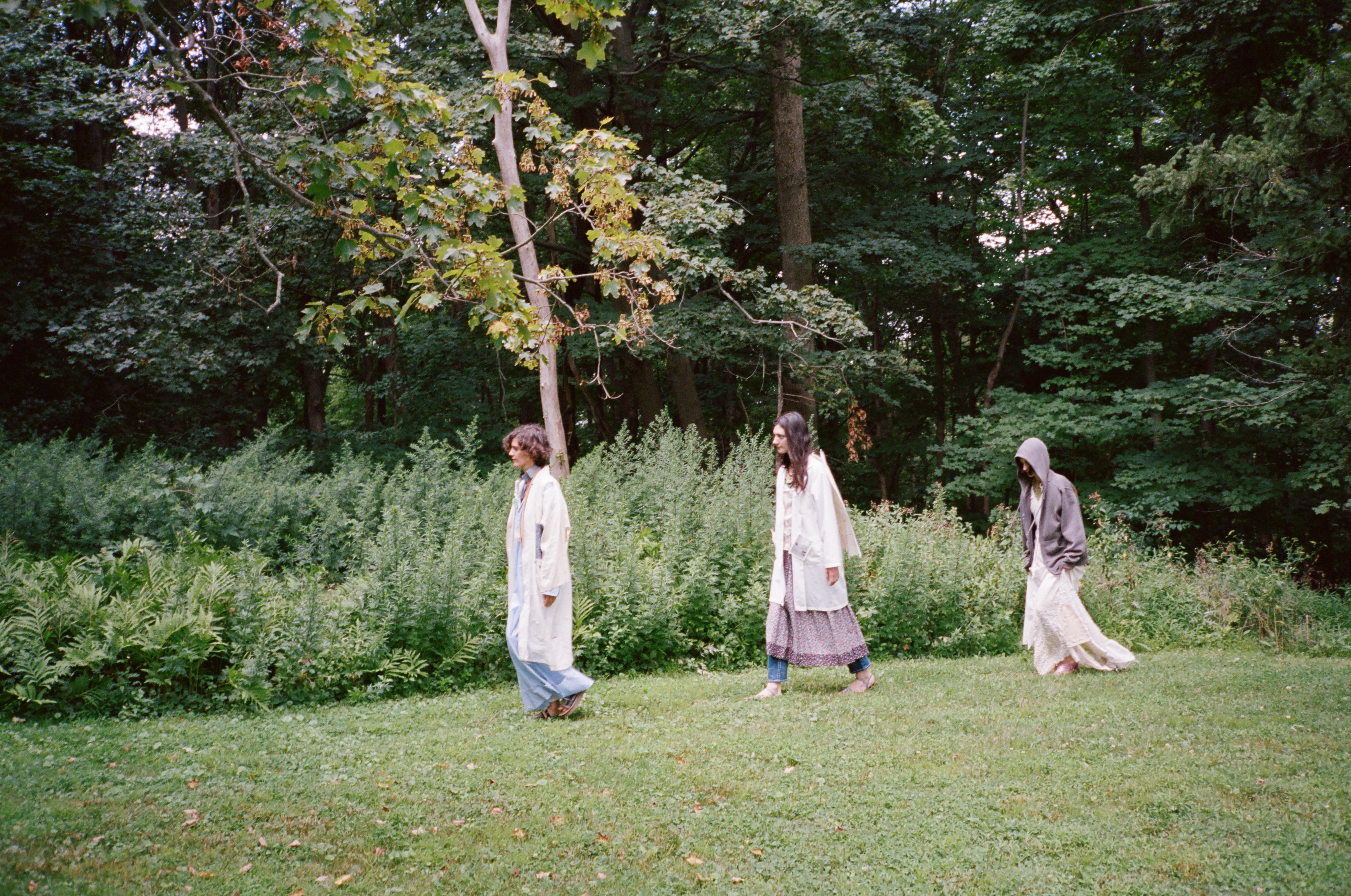
If you start in Manhattan and follow the Hudson River north, you will eventually hit Ossining, New York. It is one of those edenic hollows that feels light-years from the city even though it’s only 90 miles away. Here, on the boundary between the manufactured and the wild, is where I meet artist Susan Cianciolo one muggy August morning.
“We found something on the way,” says Cianciolo, pulling a net of logs out of her trunk like a magician with a rabbit. Artist Bunny Lampert modeled the impromptu purse in the parking lot. “We bought them at the gas station,” she says striking a pose. Lampert had driven up with Cianciolo. I had carpooled with photographer Mary Manning and painter Monique Mouton.
It is a small crew. This is how Cianciolo prefers it. When producing films and photoshoots, she is a one woman show. Cianciolo plays creative director, stylist and makeup artist. Her one condition is that everyone else on set must be actively involved in each shot. “Small groups allow more room for error,” Cianciolo says, when asked her preference. “Subjects are able to be themselves with less of a crowd. There is time to reflect and use instinct and be quiet.”

The entire day has a ceremonial quality to it. The setting and the garments that Cianciolo had selected, for example, were inspired by a final wedding scene she never shot for her 2016 film, When I Saw Your Fist Eye I Love You.
We begin our ritual by setting up camp, unboxing tomatoes, plums and cake while Cianciolo pulled clothes out of her Mary Poppins bag. Some of the aprons, belts and shirts had been worn by waiters during the 2017 Whitney Biennial. At the event, Cianciolo had restaged Run Restaurant, her 2001 pop-up diner, with the help of Untitled, the museum’s in-situ restaurant.
“They left all sorts of things in the pockets: pencils, credit cards, lip gloss,” Cianciolo laughs, unfolding a blue work shirt with postcards pinned to its pockets. These are the kind of axiomatic details that thrust her designs into the avant-garde.
Originally trained as a fashion designer at Parsons School of Design, Cianciolo uses the formal qualities of garment-making to investigate more abstract ideas surrounding the body, memory and value. Cianciolo originally presented her work as Run, a label she started in the 1995. Run was an exhibition model that enabled Cianciolo to not only explore sculpture, but drawing, performance, film and photography too.
A pioneer of the non-traditional runway show, Cianciolo debuted her collections in social spaces, namely restaurants and galleries. Her practice evolved in 2001 when she abandoned the fashion schedule in favor of an independent studio.

Run Restaurant served as a kind of transition piece, a space where her interests—cooking, fashion, sculpture and community—could collide. These days you are most likely to find Cianciolo’s work in a gallery or museum. Her garments are no longer presented on catwalks but as kits, an assemblage method, she pioneered at her last official collection, Run 11. At her 2015 Bridget Donahue solo show, visitors were invited to carefully explore each of Cianciolo’s “kits.” Each box contained a different items, from handmade clothing and sculptures to personal photographs and found ephemera. After a celebrated run in New York, her kits traveled to 365 Mission for more viewers to unpack.
While her work often involves handwork, Cianciolo does not see herself as attached to craft. It is a material proclivity she sees more of as fate than choice. “It has been a way of life that chose me,” she says.
When donning her clothing one is enchanted by the details, the delicacy, the softness, but it is not the individual elements that transform the garment into a second skin, it is their sum. One can incorporate the piece into themselves or it can stand on its own like a portrait or a ghost. Each garment is artwork that is able to mimic our own paradoxical capacity for both independence and dependence.

“I want people to be comfortable when wearing my clothes,” says Cianciolo, as she helps Mouton into a skirt with a tourist scarf reading “I love New York” patched into its side. The scarf was a donation from a friend. The artist often reappropriates her friends cast offs, as well as her own.
Cianciolo does not obey the production schedule or methods of the fashion world, yet her work retains some of its primal and fantastical essence. Her garments are not made for cold-faced editorials but for storytelling. Each conscious and unconscious detail is another portal, another chapter that fleshes out her world. When unarchiving a kit or watching a film, one feels like they are decoding, unraveling a myth that is equal parts fact and fiction.
This magical quality enters the work at its conception. While watching Cianciolo direct, I’m mesmerized by the way she choreographs serendipity. She dressed us, arranged us into primary scenarios and then lets fate take control. She doesn’t crouch over Manning but instead stands at a distance, as if observing some greater pattern in our movements. It’s a constellation I cannot not see. . . it feels as though she composes each new scene.
“It is interesting to have a dream idea of a very specific place and concept and then the time you want to created it passes and it still happens at another time,” Cianciolo says, reflecting on our day in the sun. “It showed me that linear time doesn’t exist, although I always knew that. I needed to be reminded that some ideas come much sooner than when they shall exist on the physical plane.”




